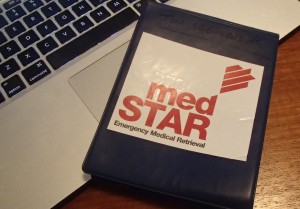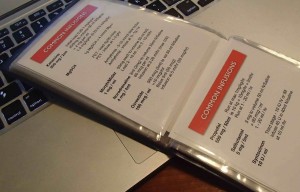I’ve been playing around with cognitive aids such as checklists and action cards for a couple of years (some are available via the RESOURCES section of this site or RURALDOCTORS.NET. Most of these were designed for handing off to nursing staff in the rural ED, partly to mitigate against the phenomenon of people disappearing off to the ‘big book of infusions’ to look up compatibilities during infrequent care of critical patients. I certainly have no problem with cognitive offloading and use of such aids in a crisis – pilots do it, and I think use of action cards is an under-utilised phenomenon in the emergency medicine.
These checklists and action cards were designed to be used both in printed format or electronically as PDFs (ipads are great for this). However working in the prehospital environment soon teaches that reliance on technology (particularly iPad or iPhone) is not without problems – mobile coverage is dismal in country (and can be at altitude)…and power failures, inadvertent water splashes or hard knocks can trash iShiny devices too easily. Recognising this, MedSTAR issue their staff with a “Vuey Tuey” – basically a 20 page clear pocket folder that fits easily in a flight suit pocket. It contains useful phone numbers, flight times to rural hospitals and other useful information.


I’ve snaffled a few of these “Vuey Tueys” from eBay (they’re also available from Army Surplus stores online). The 40 page one is not overly thick (about 1cm) and accommodates 80 sheets of paper. The aim was to create a series of action cards useful for rural doctors, particularly members of the South Australian Rural Emergency Responder Network (doctors who respond to prehospital incidents to back up local volunteer crews where no ICP available).
So here’s a series of RERN ACTION CARDS – designed with members of the South Australian rural doctor RERN team in mind – but the content may be useful for any rural doctor who is looking for a quick pocket reference that can be easily adapted to local use.
The original was created in Pages on OSX, then converted to indivdiual PDFs and merged into one document. I am more than happy to share original files if anyone wants them to modify, or can download the entire PDF here.
One quirk of the “Vuey Tuey” is the page size – 95 x 135mm! So I generally print out two sheets onto A4 and trim up with a paper cutter.
Contents include:
- principles of prehospital care
- airway
- breathing
- circulation
- crisis algorithms
- drug doses
I am a big fan of making content available for all to share – and am happy to add extra sections or modify content if needed.
I should also emphasise that this content is NOT from MedSTAR, but a collation of various tips and FOAMed that I’ve found useful. Interestingly some retrieval services make their content available to share – I remain impressed with the efforts of SydneyHEMS, AucklandHEMS and UK-HEMS in this regard. Indeed, Karel Habig and colleagues gave some useful lectures at the 2014 Rural Medicine Australia conference – it’s refreshing to see such content from prehospital care creeping into rural arenas – and the PROTECTAustralia paradigm is very worthwhile.
Certainly with approx 2/3rds of trauma coming from rural areas, it makes sense to engage with rural clinicians and strive to drive “quality care, out there”
I am no expert, but seems to me that much of critical care is about doing the basics, well – and that whilst some rural doctors embrace the challenge of managing these patients, others are understandably nervous or feel under-prepared. I think this is where FOAMed, delivering asynchronous content, robust clinical governance and standardisation of protocols such as infusions etc can make a difference.
Anyhow, here are the cards. It’s a work in progress. Enjoy!
RERN ACTION CARDS – click to download (NB RERN = Rural Emergency Responder Network)
Feedback and suggestions for additions/alterations welcomed.
Hey Tim,
These cards are excellent! Thanks for sharing.
1 comment/question for you: I’m still a novice in critical care, but I’ve been told by multiple preceptors (and some FOAMED folks as well) that due to the hypotensive effects of propofol that it is essentially contraindicated for induction in the critically ill – especially bleeding patients. Any thoughts on this?
Hi Brady
Indeed – there’s a classic rant from Cliff Reid on this (the propofol assassins)
if you havent heard it, you can listen by clicking this link
http://ruraldoctors.net/anaesthesia/airway/
then scrolling down to the #5 “don’t be a propofol assassin” and listen there
There is no “one size fit’s all”. In experienced hands, happy to use ANY agent – just markedly reduce the dose. I have seen people execute patients with propofol – by slugging in a full 200mg induction dose – it works in theatre for a fit rugby player, but is completely inappropriate in resus with a clapped out patient
I like ketamine – but if (as with any agent) one needs to get familiar with the endpoint. Can use propofol-thio-ketamine (or etomidate if have it – we dont in Oz); just need to reduce dose – approx 1/10th of usual induction and may need to consider titration as part of mRSI
Ketamine is probably the most forgiving. But it’s all about the right drug, in right hands at right time. Not a “one size fits all”
Hi,
Great work – very professional!
The PDF needs bookmarks for navigation, not sure how to do this with your workflow, but I can add them and send you the updates.
Wanna make an iOS app?!
🙂
Thanks. There are some (previous) action cards designed for use on iPad at http://ruraldoctors.net/emergency/resources/ – it’s relatively easily to make contents and allied cards hyperlinkable.
However the idea of these RERN cards is to be printed out into a VueyTuey – whilst I like my iShiny, experience has shown me that anything that relies on power, wi-fi or can be corrupted by being dunked n the rain is a hazard in the prehospital environment.
To be honest, the BEST action cards are those that can be pulled out in a crisis and given to a member of nursing staff eg : “here’s the card for isoprenaline infusion – I need you to take this vial and this card, go over to the workbench and make up the infusion as stated, then come back and tell me when done” – in the rural environment, we may only do this sort of thing once a year, so unfamiliarity and de-skilling is a real issue, Action cards for crises help obviate against this.
tim
Can be worth sealing up the top of the pockets with transpore(the clearish plastic tape). I used to get very sweaty pockets ( or take a dunk in a river) and found a bit of tape prevented moisture from making the paper moist and gave my orders/quick reference cards more longevity.
Later I found it worth printing permanent items on Rite in Rain Paper
Pingback: Lessons for management of acute agitation in rural EDs - KI Doc
Pingback: Airway Thrills - KI Doc